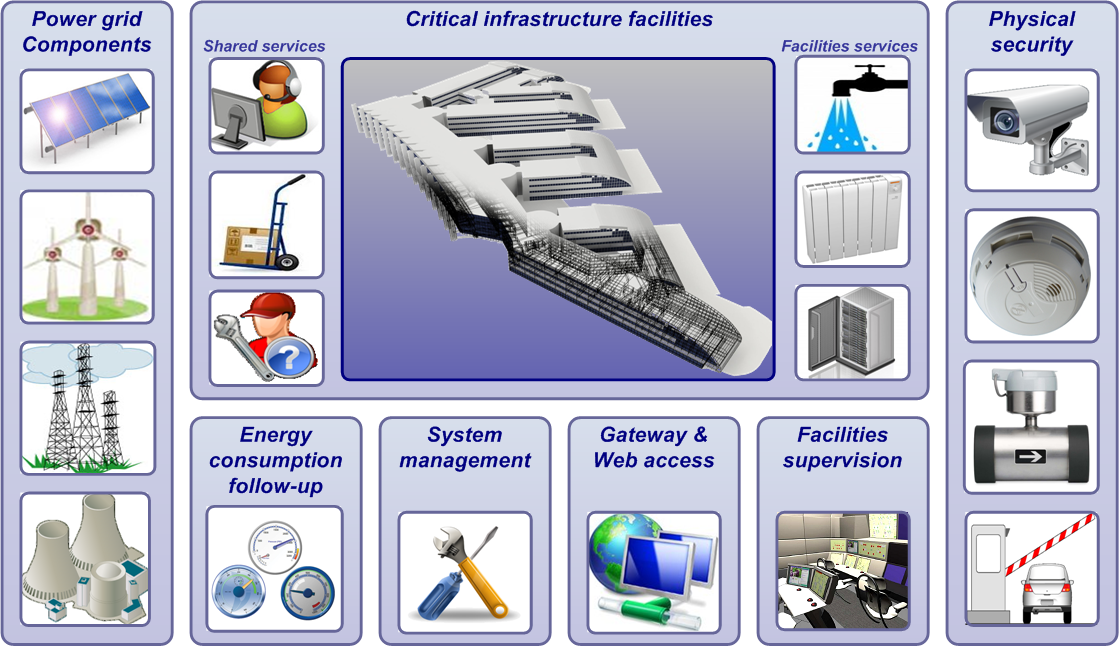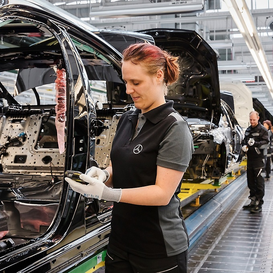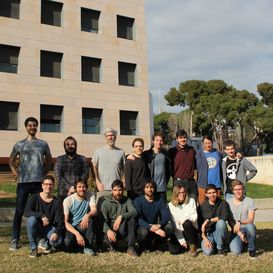FUSE-IT
Enhanced connectivity and security for building management at lower costs

Imagine that a malicious hacker is taking over the heating, ventilation and air conditioning system of a hospital, changing the temperature in such a way that diseases can easily spread in a place where people are actually supposed to be healed. A bit of a scary scenario, but with all of the equipment and facilities becoming more and more connected in order to make the systems smart and save a lot of energy, this has become a serious threat that needs to be taken into account. Should we be afraid to go to hospital now? Luckily not, as cyber security is also becoming increasingly successful in addressing these issues. And one of these success stories can be found in the FUSE-IT project, project, which was led by Airbus CyberSecurity and ran from October 2014 until December 2017. This ITEA project gathered 20 strong partners from France, Belgium, Portugal and Turkey. Airbus CyberSecurity acted as the project coordinator and pilot site for France while Gazi Technopark in Turkey, Imec’s HomeLab in Belgium and Centro Hospitalar São João in Portugal acted as pilot users for demonstrations performed in an operational environment in 2017.
FUSE-IT addressed the need for sustainable, reliable, user-friendly, efficient, safe and secure Building Management Systems in the context of Smart Critical Sites. From a site management perspective, it solves the dilemma of efficiency and security in intelligent buildings. At the user level, a smart unified building management interface enables the daily monitoring and control of a building, while a full security management interface enables the supervision of both physical and logical security throughout the premises. And at the end-user level, this can save both energy and lives.
Smart Secured Building System
To achieve this, the project developed a Smart Secured Building System resulting from crossdomain innovation between energy and security activities that are traditionally very segmented. The system can be deployed as standalone components, as a fully-integrated system or as a service. The innovation proposal of FUSEIT resides in five key capacities which were demonstrated with striking progress beyond the State-of-the-Art of the application areas of energy, facility, ICT and security.
- Secure shared sensors, effectors and devices: smart interoperable sensors, easily deployable on legacy building infrastructures, enabling the measurement of efficiency and security-related indicators in real time for improved management in enhanced security conditions.
- Trusted, federated energy and information networks: enabling the conveyance of these measurements under time-sensitive constraints through unified network infrastructures while ensuring end-to-end data protection.
- Core building data processing and analysis: a scalable data processing capacity, enabling the extraction of real-time performance and security indicators from vast amounts of heterogeneous building data.
- Smart unified building management interface: a user-friendly building management interface providing live indicators and alerts on highly realistic 3D building models as well as historical data and statistics for improved facility management and energy optimisation.
- Full security management interface: an integrated security supervision Human-Machine Interface (HMI) enabling the management of blended cyber and physical threats and decision support to responders in charge of building and network protection.
A pioneer project with impressive results
On the back of the project results, Airbus has successfully filed a patent on a method for securing and authenticating telecommunication. Overall, the project has led to the acceptance of four patents. Notable results of the FUSE-IT project have been brought to standards within the following groups: buildingSMART, CoAP, LWM2M, IPSO, oneM2M, Zigbee, Z-wave, Wirepas, Enocean, Alljoyn, semantic BIM and IFC data formats.

Airbus CyberSecurity has also been awarded a €740,000 contract to fulfil risk assessment surveys on 14 sites of Airbus Defence and Space in Spain, France, the UK and Germany and a contract worth €500,000 to secure a data centre organisation against cyber and physical threats. In addition, Airbus CyberSecurity has been awarded a multimillion-euro contract with an important gas transportation company, an integration contract for the protection of a large data centre’s infrastructure and several contracts with large energy production utilities and distribution system operators in the UK, France and Germany.
In Q2 2018, the French SME VTREEM launched a new SaaS product named ‘BIMValue’ to enhance, control and manage sensitive data using semantic BIM (Building Information Modelling). Thanks to this development, VTREEM was acquired by Catenda in 2019. This Norwegian software editor is specialised in BIM. One of the project participants is now involved in developing innovative integrations with SaaS and mobile applications for BIM at Catenda, while another joined Railenium (the French Research Institute for Railways) in October 2020 to develop open BIM standards for sustainable infrastructures.
The Turkish consortium members have acquired a contract for monitoring buildings as well as for the remote monitoring of several solar plants. Contract negotiations are ongoing, with a hospital and pilot installations being tested for several government organisations.
For the Belgian consortium, Niko has created the next-generation Niko Home Control platform NHC 2.0, which now has more open API interfaces. Additionally, all of their new wireless products will be based on the open standard Zigbee instead of only proprietary protocols. All of these changes will make Niko Home Control more open and available for fast and smooth integration by third parties. The FUSE-IT project has helped Niko to create a new architecture and move to said open standards, allowing them to grow faster and to become more attractive to other companies. The team is still growing and has had double-digit growth during the last five years.
Impact highlights
- A new (and misunderstood) topic when the project idea was first introduced back in 2013 was the protection of smart infrastructures against combined cyber and physical threats. This now appears in the top three areas of investment by public and private actors. From this perspective, FUSE-IT has been a pioneer project, enabling the consortium members to take a strategic lead.
- Since 2017, about €48 million in revenue has been reported in direct relation to the project results.
- The project has led to the acceptance of four patents
- Airbus CyberSecurity has been awarded a €740,000 contract to fulfil risk assessment surveys on 14 sites of Airbus Defence and Space in Spain, France, the UK and Germany and a contract worth €500,000 to secure a data centre organisation against cyber and physical threats. In addition, Airbus CyberSecurity has been awarded a multimillion-euro contract with an important gas transportation company, an integration contract for the protection of a large data centre’s infrastructure and several contracts with large energy production utilities and distribution system operators in the UK, France and Germany.
The FUSE-IT Portuguese consortium (GREEDi) built a prototype for a hospital, which is a critical form of infrastructure providing care to the population, especially during the COVID-19 pandemic. The prototype allowed the demonstration of demand-response participation in critical buildings, ensuring cyber and physical security. The Portuguese consortium will continue in a national project with exploitation projected to come at a later stage. Using the knowledge and developments of FUSE-IT, the Portuguese consortium was able to create a new solution for intelligent building management focused on a semantic-based approach to fault detection in cyber-physical environments. The C2C (Click to Control) solution is now entering TRL 8 after having been demonstrated in an operational environment. Moreover, the alarm and warning mechanisms developed in FUSE-IT were integrated in a commercial product by IPBRICK targeting critical buildings. EVOLEO developed a middleware solution that allowed it to interface with the legacy control systems of the building, including HVAC, oxygen and room pressure, thanks to up-to-date IT systems to implement new functionalities and optimisations. These developments are of great important for EVOLEO as several legacy systems can be turned into smart systems without the need for replacements or very demanding customisations or retrofits.
In summary, about €48 million in revenue has been reported in direct relation to the project results since 2017. The most striking commercial successes include:
- a total of 17 system integration/managed operation contracts in the field of smart building management and optimisation;
- a total of 25 contracts won in the field of critical infrastructure protection against cyber and physical threats for external customers from the aeronautic industry, oil & gas, electricity production, electricity distribution, healthcare, air transportation, rail transportation and maritime transportation;
- the successful market introduction of three smart building sensor network solutions, one sensor authentication and lightweight encryption solution, one identity and access management solution, one piece of sensor placement optimisation software, two forms of interactive smart building management, one form of building lifecycle management and two pieces of security supervision software;
- the successful market introduction of a start-up company delivering SaaS platform services for enhanced control and management of sensitive building information; and
- the deployment of a permanent full building micro-grid supporting sustained academic, industrial or research collaboration on matters of security and efficiency in smart buildings
A new (and misunderstood) topic when the project idea was first introduced back in 2013 was the protection of smart infrastructures against combined cyber and physical threats. This now appears in the top three areas of investment by public and private actors. From this perspective, FUSE-IT has been a pioneer project, enabling the consortium members to take a strategic lead.
More information
Other chapters
Use the arrows to view more chapters

Editorial
By Zeynep Sarılar

Country Focus: Portugal
ANI – a new generation framework to drive Portugal into the future

EVOLEO Technologies
Daring to dream

ITEA Success story: FUSE-IT
Enhanced connectivity and security for building management at lower costs

Viewpoint on mentorship
Mentoring is...

SotA highlight
IoT: where do we stand?

Community Talk with Raúl Santos de la Cámara
The rewards of being part of a strong Community

End user happiness: MOSIM
Digital human simulation helps manufacturers improve productivity and safety

ITEA Success story: 3DPathology
A digital pathology solution for more effective and efficient treatments

SME in the spotlight: Clevernet
The intelligent way to transfer data

AI Call 2020 ITEA projects
Diverse and promising innovations improving AI

ITEA Cyber Security Day 2021
Understanding and solving cyber security challenges together


